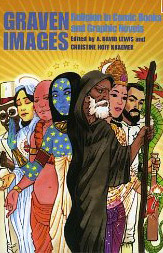Graven Images
Religion in Comic Books & Graphic Novels
by A. David Lewis (Editor), Christine Hoff Kraemer (Editor), Douglas Rushkoff (Foreword)
Copyright: 2010
Publisher: Continuum
Comic books have increasingly become a vehicle for serious social commentary and, specifically, for innovative religious thought. Practitioners of both traditional religions and new religious movements have begun to employ comics as a missionary tool, while humanists and religious progressives use comics’ unique fusion of text and image to criticize traditional theologies and to offer alternatives. Addressing the increasing fervor with which the public has come to view comics as an art form and Americans’ fraught but passionate relationship with religion, Graven Images explores with real insight the roles of religion in comic books and graphic novels.
In essays by scholars and comics creators, Graven Images observes the frequency with which religious material—in devout, educational, satirical, or critical contexts—occurs in both independent and mainstream comics. Contributors identify the unique advantages of the comics medium for religious messages; analyze how comics communicate such messages; place the religious messages contained in comic books in appropriate cultural, social, and historical frameworks; and articulate the significance of the innovative theologies being developed in comics.
Endorsements:
Graven Images excels at offering sophisticated interpretations of comic books and graphic novels that demand critical attention… Undoubtedly, Graven Images is a valuable contribution to the study of religion and popular culture. For religion scholars engaged in comic book/graphic novel criticism, the collection sets a high mark and will likely become an essential reference point for those in the field. For general scholars of religion or popular culture, Graven Images offers insight into how religion is a self-conscious engagement for comic book authors and readers, yielding works of depth and power within genres frequently dismissed as child’s play.
—Thomas Nesbit, The Journal of Popular Culture
Unlike so many studies of, say, “religion and film” that continue to treat the audio-visual medium as if it were a type of literature, the contributors here take the comics medium seriously, juxtaposing analyses of words, frames, pages, and images, and pointing toward comics as a whole. […] Graven Images establishes comics as a vital subject matter, and provides an array of strong essays that display various ways the comic-religion relation can be seen.
—S. Brent Plate, Relegere: Studies in Religion and Reception
As much as comics deal with religion, analysis of religion in comics is sadly lacking. […] Happily, Graven Images is the first step in filling that gap in scholarship.
—Rebecca Buchanan, Sequential Tart
In the mind of the present reviewer, there was not a single weak piece in this collection, and all were enjoyable and insightful, and well worth reading.
—Phillip A. Bernhardt-House, Eternal Haunted Summer
Every art form has told stories of faith, and sequential art embodiments have included Egyptian tomb paintings, the traditional Stations of the Cross, and Bible comics from the last century. With the recent graphic novel boom, religious themes and interpretations abound, mostly summarized in a dozen or so popular books like Stephen Skelton’sThe Gospel According to Superheroes, Arie Kaplan’s From Krakow to Krypton: Jews and Comic Books, and Jeff Dunn and Adam Palmer’s The Soul of Spider-Man: Unexpected Spiritual Insights from the Legendary Superhero. Graven Images appears to be the first to take a broader and more academic approach, collecting 21 essays from a conference of the same name held at Boston University. While most of the contributors have faculty appointments, five are comics creators. Themes range across religions and denominations, from expected topics (animistic and Christian themes in the manga/anime Nausicaa) to surprising ones (connections between religion and underground comics). VERDICT: This varied and thoughtful collection invites more serious consideration of the medium thematically and hopefully presages additional conferences and collections. For all academic and larger public libraries.
— Library Journal
